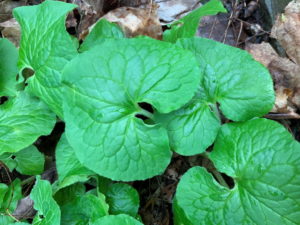Nature Views from Our Interns
FIRST DAYS OF AUTUMN by Olivia Conforti
At the River Walk the first days of autumn have passed and it is nice to see the subtle changes. While working I took a walk to check on the situation regarding branches and I saw plenty of the usual changes. The leaves were changing their colors and falling and had to be raked up. Passing the Katsura tree on the upper River Walk I noticed something, a different smell to the usual crisp smelling smells that punctuate the air. Elia, one of the trail supervisors from Greenagers, says that it smells like baked goods, but it was hard to tell at first. This smell is one of the smaller changes that comes with Autumn and all of its beauty.
For MORE…

- Olivia Conforti, October 30, 2020
GEORGINA GODFREY on RIVER WALK’S CREATURES and PLANTS
This spring while working on the River Walk, I decided to familiarize myself more with the species we support there. At first I focused on insects and invertebrates, as they are an often overlooked part of our natural world. However, as I began to document my findings I could not help but notice how many interesting creatures and plants live on the River Walk that I was not familiar with, but curious about. I decided to start an iNaturalist page to collect and identify all different sorts of life, and make it available for curious community members too.

This strange leaf growth is due to the Elm Finger Gall Mite (Aceria parulmi).

This interesting little bug is a Clavate Tortoise Beetle (Helocassis clavata).
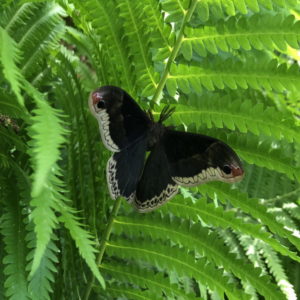
I was able to identify this Promethea Silkmoth (Callosamia promethea) that Christine Ward photographed on the trail.
- Georgina Godfrey, June 19, 2020
SASHA DeCARO on SPRING AND RIVER WALK’S CLOSING
Although spring is here, the entrances to River Walk, both down and upstream, are still closed due to the pandemic. As a River Walk apprentice, I am trying to keep the trail well maintained and cared for, as I would if the trail was open to the public. These times have been difficult for all of us around the world, but what brightens my day is watching spring greet us with adorable buds, flowers like these crocuses, and plants starting to bloom along the River Walk. I hope everyone can still find little things in the world that brighten their days as well!!
- Sasha (Alexandra) DeCaro, April 6, 2020
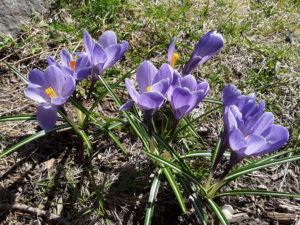
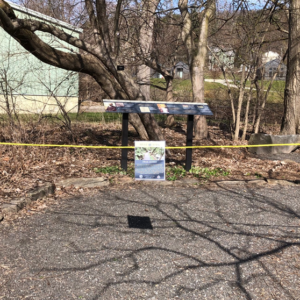
CICADA by Olivia Conforti
Few people like insects in general. I thoroughly dislike them. Minus bumblebees, most insects are pretty gross in my humble opinion. And so I was initially shocked upon receiving a cicada cadaver to study, but after a bit of research, I’ve come back with three cicada facts!
1. Do you hear those familiar drumming sounds during the summer? They are made by male cicadas attempting to attract female cicadas. The mating season of cicadas is reportedly during the spring and summer, when ground temperatures warm. Until this point, cicadas live their nymph stage underground. They need warm ground temperatures as an incentive to mate.
2. Cicadas have a hard exoskeleton that makes them recognizable in the insect world, dead or alive. One spooky cicada fact: cicadas can climb out of their exoskeletons. Like the nightmare creatures by artist H. R. Giger of “Alien” fame, cicadas can be terrifying.
3. My last cicada fact is a little less disgusting. Has anyone tried fried cicada? It’s a delicacy in certain parts of the world. I think being deep-fried and eaten is an even worse fate for the cicada than being killed by a cicada killer wasp.
- Olivia Conforti, September 30, 2019
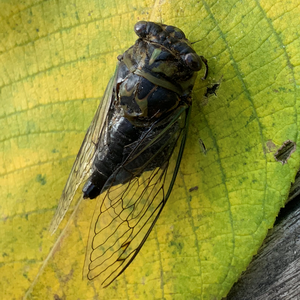
TREE WALK
On July 13, a small group joined local arborist Tom Ingersoll for a guided tree walk along River Walk’s downstream trail and had much to learn. Mr. Ingersoll discussed the Red Oak suffering ground compression at Bridge Street and the origin of the Catalpa tree. He offered a way to identify unfamiliar trees, using the acronym MADCap Horse CLICK . We learned a non-invasive way to identify the age of the large Cottonwood along the downstream alley (80-100 years), based on the tree’s height and trunk width.
Recommended Reading: The Hidden Life of Trees by Peter Wohlleben (a literary introduction to studying trees);
Botany of Desire by Michael Pollan: and
The Manual of Woody Landscape Plants by Michal Dirr
- Olivia Conforti, September 5, 2019
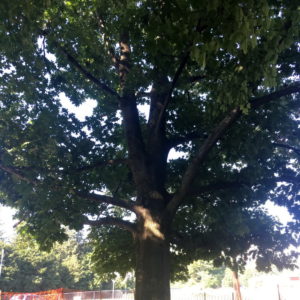
TULIP TREE
The Tulip Tree or Liriodendron tulipifera is present in the downstream area of the River Walk and near the W. E. B Du Bois River Park. Its leaves are shaped in a flat four to six points, which look similar to a cat’s face or tulip. The Tulip Tree also gets its name from the tulip-shaped flowers that bloom in its branches. When the bark is removed, it has a fragrant, sweet, and delicious smell. The Tulip Tree can grow to become colossal, close to 70 to 100 feet.
- Olivia Conforti, July 8, 2019
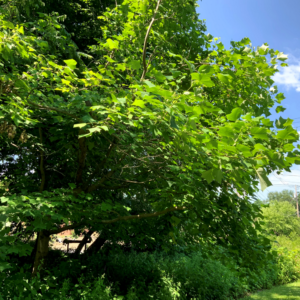
JACK-IN-THE-PULPIT
Jack-in-the-Pulpit or Arisaema triphyllum is a plant that is coming to the end of its blooming season on the River Walk. It is a common plant that can be found on the upstream section. Jack- in-the-Pulpit is pollinated by fungus gnats, which are attracted to the smell. It flowers from April until June, leaving behind fruit-like seeds. Jack-in-the Pulpit is known for its oxalis acid, which is toxic when ingested, but if the plant is properly dried and cooked it can be eaten as a root vegetable.
- Olivia Conforti, July 8, 2019

DRYAD’S SADDLE
Cerioporus squamosus aka Polyporus squamosus or Dryad’s Saddle is a mushroom that can be seen forming “shelves” on the side of a tree on River Walk’s upstream section. The mushroom is also called pheasant’s back mushroom for the pattern of colors, which are similar to a pheasant bird’s feathers. The mushroom can either be found alone or in clusters that look like shelves. Dryad’s Saddle is one of many edible mushrooms in the Berkshire County region. Many mushroom connoisseurs claim that it has the taste and smell of watermelon rinds, but collectors prefer younger specimens when it comes to eating it. Please remember that the harvesting of plants in not allowed on the River Walk.
- Olivia Conforti, July 8, 2019
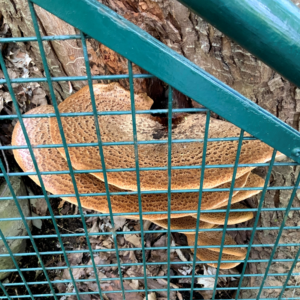
RED TRILLIUM
Trillium erectum or Red Trillium, which is also called the Wake Robin, is a flowering plant that is at the end of its flowering season on the River Walk. It is a member of the lily family, which has diamond-shaped leaves that are in a whorl-shaped pattern. It usually has three petals and three plant parts that aren’t petals. The flower is usually another plant, along with the Wild Ginger, that attracts flies as its main pollinator by emitting a foul smell. The plant will also eventually produce berries that are eaten by birds and animals.
- Olivia Conforti, May 25, 2019
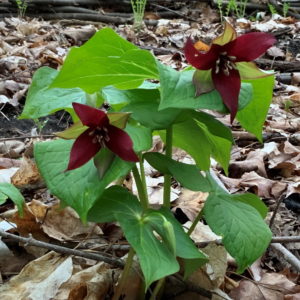
WILD CANADIAN GINGER
Wild Canadian Ginger or Asarum canadense is a local wildflower that grows on the upper bank of River Walk’s upstream section. It has heart-shaped leaves and the three-petaled flowers grow at the base of the plant. Another noticeable feature of this plant is the soft and fuzzy coating on the stems and leaves. The soft fuzz acts as insulation and protection to keep the plant warm during the early season when it first grows. Over time the fuzzy coating will be less prominent as the plant grows older, revealing a flower-like pattern through the veins. The flower does not have a sweet scent and smells like a decaying plant in order to attract flies that are its main pollinator.
- Olivia Conforti, May 2, 2019

